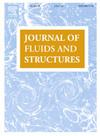Parallel water entry of hydrophobic-hydrophilic sphere pairings: particle image velocimetry and High-Speed camera analysis
IF 3.4
2区 工程技术
Q1 ENGINEERING, MECHANICAL
引用次数: 0
Abstract
This study provides further investigation on parallel water entry of pairings of hydrophobic-hydrophilic spheres. In a prior publication by the current authors (Akbarzadeh et al., 2023), a distinct phenomenon termed “second pinch-off” was observed for certain scenarios of parallel water entry of equally-sized hydrophobic-hydrophilic spheres. This experimental study examines this event more comprehensively. Experiments with differently-sized spheres are also conducted and analyzed. In the equally-sized cases, two spheres with a diameter of , positioned in a lateral distance of 1.5 times the diameter, are released simultaneously from heights ranging from 25 to 55cm. This corresponds to impact velocities of . In these configurations, the vortex shedding behind the hydrophilic sphere significantly influences the air cavity produced by the hydrophobic sphere. A high-speed photography system, coupled with an image processing technique, is employed to analyze the event dynamics. Additionally, a Particle Image Velocimetry system is utilized to capture the flow field, extracting both velocity and vorticity fields. The analysis demonstrates that a vortex ring forms behind the hydrophilic sphere and causes some waviness in the cavity interface. This vortex ring is shed and migrates towards the cavity wall causing an indentation which grows over time and finally completely severs the air cavity (second pinch-off). Furthermore, the results highlight that the second pinch-off time, in non-dimensional form, correlates linearly with the impact Weber number. The findings for the case of differently-sized spheres ( and in diameter), reveal that a second pinch-off event can also be observed in pairings where the smaller sphere is hydrophilic.
亲水-疏水球对平行入水:粒子图像测速和高速相机分析
本研究为疏亲水球对平行入水提供了进一步的研究。在当前作者(Akbarzadeh et al., 2023)先前发表的一篇文章中,在相同大小的疏水-亲水球体平行进入的某些情况下,观察到一种称为“第二次掐断”的独特现象。本实验研究更全面地考察了这一事件。并对不同尺寸的球进行了实验分析。在大小相同的情况下,两个直径为20mm的球体,放置在直径1.5倍的横向距离上,同时从25到55cm的高度释放。这对应于2.21 ~ 3.328ms−1的冲击速度。在这些构型中,亲水球背后的旋涡脱落对疏水球产生的空腔有显著影响。采用高速摄影系统,结合图像处理技术,对事件动态进行分析。此外,利用粒子图像测速系统捕获流场,提取速度场和涡度场。分析表明,在亲水球的后面形成了一个旋涡环,并在空腔界面产生了一定的波浪形。这个旋涡环脱落并向腔壁迁移,造成一个凹痕,随着时间的推移,最终完全切断了空气腔(第二次掐断)。此外,结果强调,第二次掐断时间,在无量纲形式,与冲击韦伯数线性相关。对于不同大小的球体(直径为12毫米和20毫米)的研究结果表明,当较小的球体是亲水的配对时,也可以观察到第二次夹断事件。
本文章由计算机程序翻译,如有差异,请以英文原文为准。
求助全文
约1分钟内获得全文
求助全文
来源期刊

Journal of Fluids and Structures
工程技术-工程:机械
CiteScore
6.90
自引率
8.30%
发文量
173
审稿时长
65 days
期刊介绍:
The Journal of Fluids and Structures serves as a focal point and a forum for the exchange of ideas, for the many kinds of specialists and practitioners concerned with fluid–structure interactions and the dynamics of systems related thereto, in any field. One of its aims is to foster the cross–fertilization of ideas, methods and techniques in the various disciplines involved.
The journal publishes papers that present original and significant contributions on all aspects of the mechanical interactions between fluids and solids, regardless of scale.
 求助内容:
求助内容: 应助结果提醒方式:
应助结果提醒方式:


